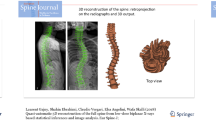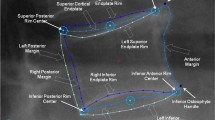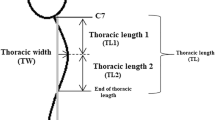Abstract
Purpose
Current standard methods to quantify disc height, namely distortion compensated Roentgen analysis (DCRA), have been mostly utilized in the lumbar and cervical spine and have strict exclusion criteria. Specifically, discs adjacent to a vertebral fracture are excluded from measurement, thus limiting the use of DCRA in studies that include older populations with a high prevalence of vertebral fractures. Thus, we developed and tested a modified DCRA algorithm that does not depend on vertebral shape.
Methods
Participants included 1186 men and women from the Framingham Heart Study Offspring and Third Generation Multidetector CT Study. Lateral CT scout images were used to place 6 morphometry points around each vertebra at 13 vertebral levels in each participant. Disc heights were calculated utilizing these morphometry points using DCRA methodology and our modified version of DCRA, which requires information from fewer morphometry points than the standard DCRA.
Results
Modified DCRA and standard DCRA measures of disc height are highly correlated, with concordance correlation coefficients above 0.999. Both measures demonstrate good inter- and intra-operator reproducibility. 13.9 % of available disc heights were not evaluable or excluded using the standard DCRA algorithm, while only 3.3 % of disc heights were not evaluable using our modified DCRA algorithm.
Conclusions
Using our modified DCRA algorithm, it is not necessary to exclude vertebrae with fracture or other deformity from disc height measurements as in the standard DCRA. Modified DCRA also yields identical measurements to the standard DCRA. Thus, the use of modified DCRA for quantitative assessment of disc height will lead to less missing data without any loss of accuracy, making it a preferred alternative to the current standard methodology.




Similar content being viewed by others
References
Katz JN (2006) Lumbar disc disorders and low-back pain: socioeconomic factors and consequences. J Bone Joint Surg Am 88(Suppl 2):21–24. doi:10.2106/JBJS.E.01273
Luoma K, Riihimaki H, Luukkonen R, Raininko R, Viikari-Juntura E, Lamminen A (2000) Low back pain in relation to lumbar disc degeneration. Spine (Phila Pa 1976) 25:487–492
Kraemer J (1995) Natural course and prognosis of intervertebral disc diseases. International Society for the Study of the Lumbar Spine Seattle, Washington, June 1994. Spine (Phila Pa 1976) 20:635–639
Pfirrmann CW, Metzdorf A, Zanetti M, Hodler J, Boos N (2001) Magnetic resonance classification of lumbar intervertebral disc degeneration. Spine (Phila Pa 1976) 26:1873–1878
Wilke HJ, Rohlmann F, Neidlinger-Wilke C, Werner K, Claes L, Kettler A (2006) Validity and interobserver agreement of a new radiographic grading system for intervertebral disc degeneration: part I. Lumbar spine. Eur Spine J 15:720–730. doi:10.1007/s00586-005-1029-9
Kettler A, Rohlmann F, Neidlinger-Wilke C, Werner K, Claes L, Wilke HJ (2006) Validity and interobserver agreement of a new radiographic grading system for intervertebral disc degeneration: part II. Cervical spine. Eur Spine J 15:732–741. doi:10.1007/s00586-005-1037-9
Yu LP, Qian WW, Yin GY, Ren YX, Hu ZY (2012) MRI assessment of lumbar intervertebral disc degeneration with lumbar degenerative disease using the Pfirrmann grading systems. PLoS One 7:e48074. doi:10.1371/journal.pone.0048074
Frobin W, Brinckmann P, Biggemann M, Tillotson M, Burton K (1997) Precision measurement of disc height, vertebral height and sagittal plane displacement from lateral radiographic views of the lumbar spine. Clin Biomech (Bristol, Avon) 12(Suppl 1):S1–S63
Bilgic S, Sahin B, Sonmez OF, Odaci E, Colakoglu S, Kaplan S, Ergur H (2005) A new approach for the estimation of intervertebral disc volume using the Cavalieri principle and computed tomography images. Clin Neurol Neurosurg 107:282–288. doi:10.1016/j.clineuro.2004.08.001
Amonoo-Kuofi HS (1991) Morphometric changes in the heights and anteroposterior diameters of the lumbar intervertebral discs with age. J Anat 175:159–168
Abu-Leil S, Floman Y, Bronstein Y, Masharawi Y (2016) A morphometric analysis of all lumbar intervertebral discs and vertebral bodies in degenerative spondylolisthesis. Eur Spine J 25:2535–2545. doi:10.1007/s00586-016-4673-3
Agius R, Galea R, Fava S (2016) Bone mineral density and intervertebral disc height in type 2 diabetes. J Diabetes Complicat 30:644–650. doi:10.1016/j.jdiacomp.2016.01.021
Kumar MN, Jacquot F, Hall H (2001) Long-term follow-up of functional outcomes and radiographic changes at adjacent levels following lumbar spine fusion for degenerative disc disease. Eur Spine J 10:309–313
Frobin W, Leivseth G, Biggemann M, Brinckmann P (2002) Vertebral height, disc height, posteroanterior displacement and dens-atlas gap in the cervical spine: precision measurement protocol and normal data. Clin Biomech (Bristol, Avon) 17:423–431
Oner FC, van der Rijt RR, Ramos LM, Dhert WJ, Verbout AJ (1998) Changes in the disc space after fractures of the thoracolumbar spine. J Bone Joint Surg Br 80:833–839
Hoffmann U, Massaro JM, Fox CS, Manders E, O’Donnell CJ (2008) Defining normal distributions of coronary artery calcium in women and men (from the Framingham Heart Study). Am J Cardiol 102:1136–1141
Samelson EJ, Christiansen BA, Demissie S, Broe KE, Louie-Gao Q, Cupples LA, Roberts BJ, Manoharam R, D’Agostino J, Lang T, Kiel DP, Bouxsein ML (2012) QCT measures of bone strength at the thoracic and lumbar spine: the Framingham Study. J Bone Miner Res 27:654–663. doi:10.1002/jbmr.1482
Brett A, Miller CG, Hayes CW, Krasnow J, Ozanian T, Abrams K, Block JE, van Kuijk C (2009) Development of a clinical workflow tool to enhance the detection of vertebral fractures: accuracy and precision evaluation. Spine (Phila Pa 1976) 34:2437–2443
Kim YM, Demissie S, Eisenberg R, Samelson EJ, Kiel DP, Bouxsein ML (2011) Intra-and inter-reader reliability of semi-automated quantitative morphometry measurements and vertebral fracture assessment using lateral scout views from computed tomography. Osteoporos Int 22:2677–2688. doi:10.1007/s00198-011-1530-4
Lin LI (1989) A concordance correlation coefficient to evaluate reproducibility. Biometrics 45:255–268
Adams MA, Pollintine P, Tobias JH, Wakley GK, Dolan P (2006) Intervertebral disc degeneration can predispose to anterior vertebral fractures in the thoracolumbar spine. J Bone Miner Res 21:1409–1416. doi:10.1359/jbmr.060609
Acknowledgments
This study was funded by grants from the National Institutes of Health (R01AG041658, R01AR053986, R01AR41398, and F31AG041629). The Framingham Heart Study is supported by Contract Number HHSN268201500001I from the National Heart, Lung, and Blood Institute (NHLBI) with additional support from other sources. The contents are solely the responsibility of the authors, and do not necessarily represent the views of the NIH, the Framingham Heart Study or the NHLBI.
Author information
Authors and Affiliations
Corresponding author
Ethics declarations
Conflict of interest
The authors declare that they have no conflicts of interest.
Rights and permissions
About this article
Cite this article
Allaire, B.T., DePaolis Kaluza, M.C., Bruno, A.G. et al. Evaluation of a new approach to compute intervertebral disc height measurements from lateral radiographic views of the spine. Eur Spine J 26, 167–172 (2017). https://doi.org/10.1007/s00586-016-4817-5
Received:
Revised:
Accepted:
Published:
Issue Date:
DOI: https://doi.org/10.1007/s00586-016-4817-5




